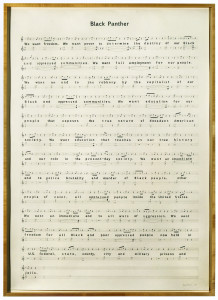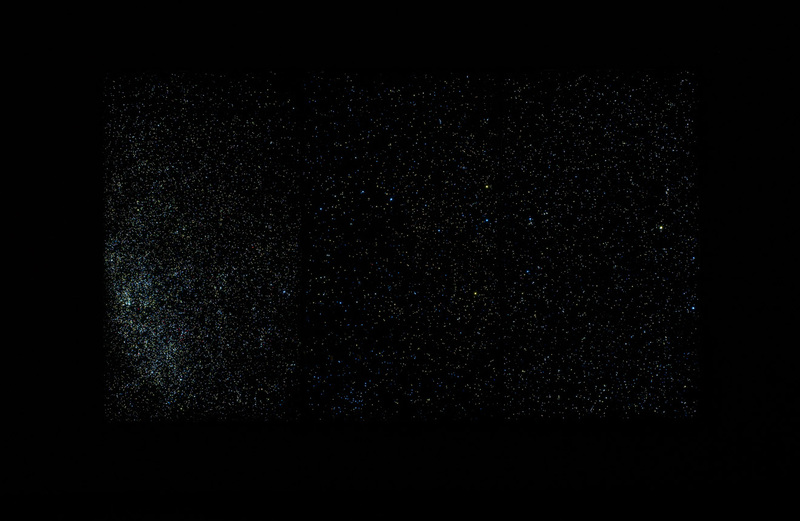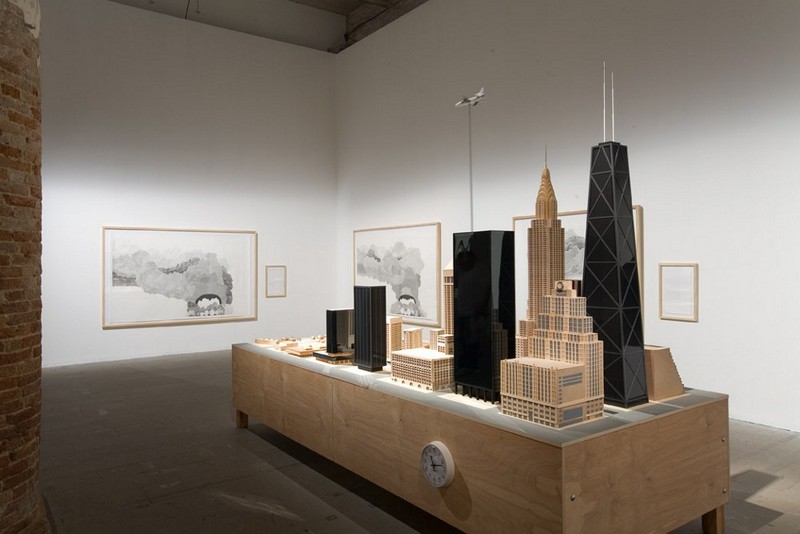
Charles Gaines participates with ‘Manifestos 1’, 2008, in Biennial Montreal, till February 5, 2015 and with’Skybox 1′, 2011, in Prospect 3, New Orleans till January 25, 2015..
Manifestos, 2008
Since the 1970s, Charles Gaines has produced highly formal conceptual works that bring into play disparate artistic and political positions by means of a disciplined system or set of rules. Gaines’ interest in systems aesthetics can be related to the systematized work of minimalist, Fluxus and early conceptual artists, yet his works differ in their preparedness to engage directly with prosaic, social, political and philosophical propositions. As a result, his work evokes the far-ranging sets of relationships that shape the humanitarian concern for social justice.
In Skybox I (2011), a twelve-foot-long light box presents texts on human rights from seventeenth-century religious reformer Gerard Winstanley and twentieth-century philosophers and political leaders Léopold Sédar Senghor, Frantz Fanon and Ho Chi Minh. The texts gradually fade to black to reveal the night sky at the time of their writing, a sky that is also ever incrementally changing. Manifesto 2 (2013) references four manifestos, including An Indigenous Manifesto (1999) by Canadian Taiaiake Alfred and Malcolm X’s last speech in 1965 at Detroit’s Ford Auditorium. For BNLMTL 2014, he is presenting the precursor Manifestos (2008), which quotes revolutionary manifestos of the Socialist International Congress, the Situationist International, the Black Panthers and the Zapatista Army of National Liberation. The texts of the manifestos are then translated through a baroque system to produce both scores hung as wall works and, ultimately, music emanating from four monitors to accompany images of the texts as they scroll vertically. The scores and music in turn reference a history of anthems that are motivated by revolution and protest.
 Charles Gaines, Manifestos 1, 2008, installation: four single-channel videos and four graphite on papers drawings, installation dimensions variable; video: 32 minutes (courtesy of the artist and Susanne Vielmetter Los Angeles Projects; collection of the Hammer Museum, Los Angeles)
Charles Gaines, Manifestos 1, 2008, installation: four single-channel videos and four graphite on papers drawings, installation dimensions variable; video: 32 minutes (courtesy of the artist and Susanne Vielmetter Los Angeles Projects; collection of the Hammer Museum, Los Angeles)
Biography
Born in 1944 in Charleston, SC, Charles Gaines began his professional career in 1972. He lives and works in Los Angeles. Gaines has had more than 55 solo exhibitions and several hundred group exhibitions in the United States and Europe. This summer, the Studio Museum in Harlem, New York, featured a comprehensive solo exhibition. His 2013 solo exhibition at Paula Cooper Gallery, New York, met with critical acclaim. In 2012, a mid-career survey of his work was mounted at the Pomona College Museum of Art and the Pitzer College Art Gallery in Claremont, CA. His work was also seen in the 2007 Venice Biennale and has been included in group exhibitions in Los Angeles at the Los Angeles County Museum of Art, Museum of Contemporary Art, Hammer Museum and REDCAT Gallery; and at the Lentos Kunstmuseum, Linz, Austria; Deichtorhallen, Hamburg, Germany; Kunsthalle Basel, Switzerland; and Contemporary Arts Museum, Houston.
 Skybox 1, 2011, Prospect 3. Film installation.
Skybox 1, 2011, Prospect 3. Film installation.
His work are found in collections in New York, at the Museum of Modern Art and Whitney Museum of American Art; in Los Angeles, at the Los Angeles County Museum of Art, the Museum of Contemporary Art and the Hammer Museum; at the Lentos Kunstmuseum, Linz, Austria; and at Galerie der Stadt Esslingen at Villa Merkel, Esslingen, Germany. Gaines received a Guggenheim fellowship (2013).
 Venice Installation, 2007.
Venice Installation, 2007.
He is represented by Susanne Vielmetter Los Angeles Projects and Paula Cooper Gallery, New York.

